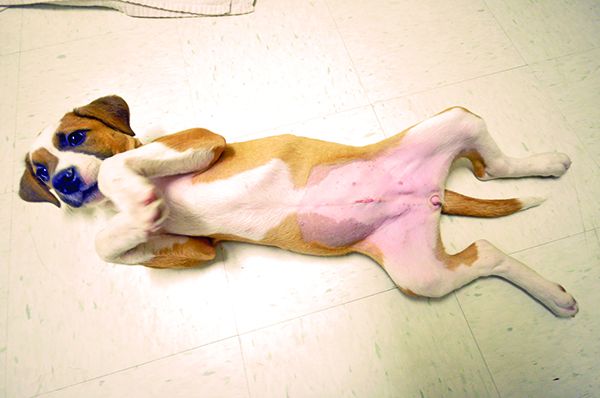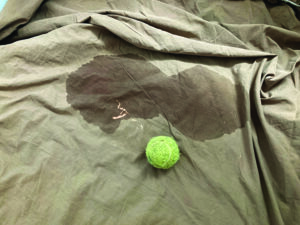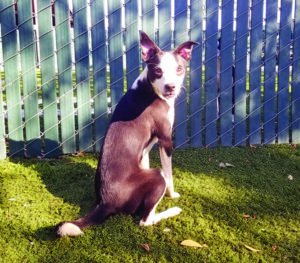
Urinary incontinence is the lack of full, voluntary control over the passage of urine. It results from failure of the bladder and/or urethra (the outlet from the bladder) to contain urine as the bladder fills. In dogs, the most common cause for this is called “urethral sphincter mechanism incompetence” (USMI), and it happens most frequently in spayed females. Other names for this condition include idiopathic incontinence, hormone-responsive incontinence, and spay incontinence.
Spay incontinence is a pretty common disorder and has been the subject of much discussion and research in medical circles, as is common when science has not yet been able to definitely understand it. Why does it happen? What exactly goes wrong physiologically? These questions have not yet been conclusively answered.
WHAT WE KNOW
During urination, involuntary nerves tell the bladder to contract and the urethra to relax. The opposite happens when urine is held in; the bladder must relax and the urethra must contract.
There are estrogen-receptor sites along the urethra, supporting ligaments, and muscles. When estrogen attaches to these receptors, the tone of the urethral sphincter strengthens. There are other receptors (alpha receptors), which also strengthen urethral tone. Estrogen is known to increase the number and sensitivity of these receptors.
In a conventional spay surgery (more formally called an ovariohysterectomy), a dog’s ovaries are removed (along with her uterus). This means she no longer produces estrogen, thereby losing these strengthening effects. As the muscles and sphincter become weaker, the urethra becomes less effective at holding back urine, and urine may leak.
About 5% of spayed female dogs will develop urinary incontinence. Of those, the vast majority are larger dogs, weighing 40 pounds or more. In the United States, Dobermans and Giant Schnauzers top the list of breeds with the highest incidence, while in Europe it is the Boxer.
The time of onset varies quite a bit. Spay incontinence usually occurs within three years of the spay surgery, although some dogs will develop symptoms within weeks of surgery.
STILL UP FOR DEBATE
There is no agreement among experts regarding the ideal timing of spay surgery and whether the age of the dog at the time of surgery affects the likelihood of her developing urinary incontinence afterward. There are studies that show it’s more likely if you spay them young (less than 6 months of age). There are also studies that say it makes no difference whether you spay them earlier or later (after 12 months).
Whether spaying before the first heat or after makes a difference is unclear. Why are the larger breeds so much more frequently affected than the smaller breeds? We just don’t know. There is at least one study that implies spaying the larger breeds later may help reduce the incidence of spay incontinence. Beyond that, the debate continues.
SIGNS
If you notice your spayed female dog is starting to leave wet spots where she lays, she may be suffering from spay incontinence. Other signs include wetness around the vulva, staining of the hair around the vulva, paying more attention to, and licking at, the vulva. The leaking is almost always intermittent and usually most noticeable after resting or sleeping. She will still urinate normally when taken out to potty, as long as there are no other compounding issues like a urinary tract infection (UTI).
WHAT TO DO

Schedule an appointment with your veterinarian and be sure to bring a fresh (no more than 30 minutes old) urine specimen, collected in a clean, dry container. I find it easiest to use something larger in diameter with a low profile for collecting urine. Just nonchalantly slide something low such as a pie plate (as opposed to a Dixie cup) behind your dog when she squats to urinate.
Once collected, pour the urine into a clean, dry jar to give to your veterinarian. The fresher the sample, the more accurate the results, so it’s not a bad idea to bring your pie plate and container to the clinic and catch your sample right outside.
In addition to running a urinalysis on the sample you bring, your veterinarian will do a thorough physical exam, including a neurological evaluation and rectal palpation. A careful history will be taken to determine the exact nature of the leaking:
• Is it intermittent or consistent?
• Large volumes or small puddles?
• After exercise or after rest?
• Does it happen only while laying down, or does she dribble while walking?
• Does she urinate normally outside?
The urinalysis, exam, and answers to these questions will help your veterinarian rule out other underlying conditions that can contribute to urinary incontinence. These include things like spinal-cord disease, kidney disease, UTI, bladder stones, and diabetes.
If all is normal at this point, your leaky dog will likely be given a diagnosis of spay incontinence until proven otherwise. There are urethral-pressure tests that can be done to prove that this is USMI, but they are expensive and will put your dog through a lot of possibly unnecessary testing. Because the available treatments for spay incontinence are safe and effective, beginning treatment and using a positive response to therapy as a diagnostic tool is acceptable.
TREATMENT

Medical therapy falls into two groups: hormone replacement (estrogen) and drugs that strengthen contraction of the involuntary muscles of the urethra (alpha agonists).
Phenylpropanolamine (PPA), an alpha agonist, is usually the drug of choice. The popular brand name is Proin, manufactured by Pegasus Laboratories. PPA is effective in 75% to 90% of dogs with spay incontinence. It is relatively safe but can cause hypertension (high blood pressure). Your dog’s blood pressure should be checked before starting therapy, one week later, again in a month, and then every six months. Other possible side effects are restlessness and agitation.
Typically, dogs will be started on twice daily PPA. Some dogs can eventually be maintained with once daily dosing. Some dogs may require medication three times a day. Proin also comes in an extended-release formulation, which may be preferable for dogs requiring three times daily dosing of the regular formula.
Dogs with high blood pressure, kidney disease, or heart disease should not be treated with PPA. Hormone replacement therapy is a better choice for these dogs.
Diethylstilbsterol (DES) is the original synthetic estrogen that was prescribed for treatment of spay incontinence. Medical concerns for human patients have made this medication harder to find, but it is available through veterinary compounding pharmacies. After a loading period of once daily for a week, many dogs can be maintained on once weekly treatment.
At the dosages prescribed for urinary incontinence, this medication is safe. But at higher dosages, or in the instance of an inadvertent overdose, it causes life-threatening bone marrow suppression, so be sure to keep it up high on a shelf where your dog can’t get to it.
Estriol is a newer, more popular estrogen. The brand name is Incurin, manufactured by Intervet Schering-Plough. This is a short-acting estrogen that is extremely safe. It is dosed once daily. After the initial two-week loading period, it’s recommended to try lower dosages to find the lowest effective dose for your dog. Sometimes this medication can cause loss of appetite and vomiting. If the dose your dog requires for effective control is high, she will sometimes start to show unwanted signs of heat (swollen vulva, male dog attention). In this case, PPA may be a better choice.
KEEP TRYING

If you’ve tried Proin to no avail, and then tried Incurin, and still had no luck in stopping the urine dribble, ask your veterinarian about trying them together. They are safe to use together, and there is frequently a synergistic boosting effect.
Any medication, or combination of medications, that works for your dog may become less effective over time, so expect ups and downs and the need for adjustment of medications. Other medications sometimes tried in refractory cases include conjugated estrogens (e.g., Premarin) and GnRH agonists (e.g., Lupron). For dogs not helped with medications, surgical options are available.
Urinary incontinence due to sphincter mechanism incompetence makes your dog more prone to UTIs, so be sure to have her urine checked periodically. This should be the first thing you do if your previously well-controlled incontinent dog starts leaking again.
In most cases, this frustrating, annoying problem can be safely and effectively managed with medication. So, if this happens to your spayed female, don’t lose hope!






Our 12 year old toy poodle/Maltese girl just started Prion a week ago. Her bladder issues started a few days before that. No more issues for her! Side note: Our 14 year old shihtzu/bichon boy was just diagnosed with bladder stones today. (Weird how both dogs had pee issues but for different reasons.)
I had a male German Shepherd years ago who was prone to bladder stones. After spending thousands on vet screenings and meds with no luck I started giving him apple cider vinegar in his food and the problem went away. Used about a capful for an 80 lb dog.
I’m experiencing the frustration of finding an effective solution for our 9 year old female Greyhound’s urinary incontinence. She completed a course of Amoxicillin for a UTI a couple of weeks ago & the incontinence continues inconsistently. Some days the leak areas are small to moderate, may skip a day, then another day HUGE wet areas where she’s been laying. Have tried Incurin without success & I will NOT use Proin– too many risks & side effects. I’ve read all the articles here about the topic & will try a couple other more natural solutions (corn silk, less grain, etc). A;so, her Vet is prescribing & ordering the Chinese herb, Suo quan wan, which I haven’t received yet. I’m hoping & praying we find a solution soon!!